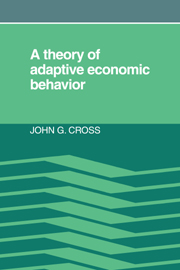Book contents
- Frontmatter
- Contents
- Preface
- 1 Introduction
- 2 Models of convergence
- 3 Behavior in the short run
- 4 Uncertainty
- 5 An application to state lottery games
- 6 An application to the problem of search behavior
- 7 Inflationary disequilibrium
- 8 Advertising and imitation
- 9 An application to migration
- 10 Conclusions
- References
- Index
8 - Advertising and imitation
Published online by Cambridge University Press: 07 October 2011
- Frontmatter
- Contents
- Preface
- 1 Introduction
- 2 Models of convergence
- 3 Behavior in the short run
- 4 Uncertainty
- 5 An application to state lottery games
- 6 An application to the problem of search behavior
- 7 Inflationary disequilibrium
- 8 Advertising and imitation
- 9 An application to migration
- 10 Conclusions
- References
- Index
Summary
It is a striking fact that every modern free-enterprise economy includes the institution of advertising. Its influence is inescapable, and it is certainly difficult to imagine any description of contemporary economic life that does not dwell at some length on its role in the determination of market processes. The fact that there is no systematic analysis of advertising to be found in the conventional economic theory of consumption would be astonishing were it not that the evident capacity of advertising to alter choice behavior is so plainly inconsistent with the optimization paradigm on which the theory is founded. Indeed, the conventional belief that advertising can induce fully informed consumers to buy what they otherwise would not buy has been a continuing source of embarrassment to economists who adhere to traditional utility-maximization models.
In defense of the traditional theory, there do exist many forms of advertising that are at least potentially consistent with optimization. If we were to confine ourselves to its information content, stressing as examples retail advertisements that describe current prices, the existence of special sales, or product availability, we could address the phenomenon by means of standard Bayesian decision techniques. As work by Boyer (1974) implies, there can be little doubt that a substantial portion of (printed) retail advertising does perform such a function, and to this extent there is no incompatibility with the rest of economic theory. On the other hand, this explanation cannot reasonably be applied to advertising that primarily serves to differentiate such technically homogeneous products as beer, aspirin, cigarettes, soap, or various paper products, and Boyer's data support this conclusion.
- Type
- Chapter
- Information
- A Theory of Adaptive Economic Behavior , pp. 151 - 165Publisher: Cambridge University PressPrint publication year: 1983



